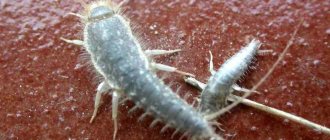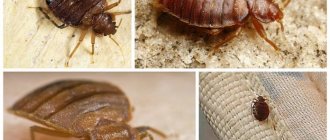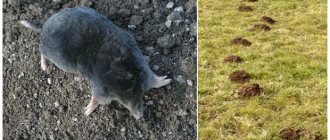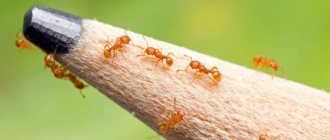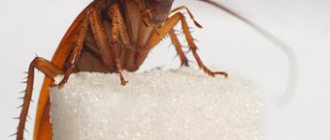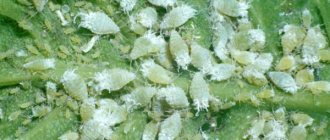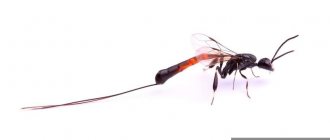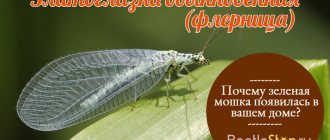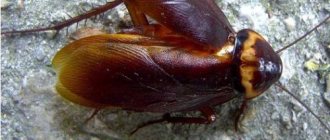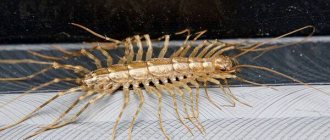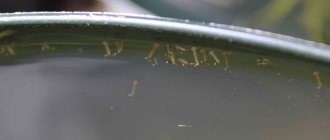Small black fleas that jump on the floor in a house or apartment and painfully bite pets and people are a cause for concern. In addition to painful bites and irritating itching, black fleas are dangerous because they carry infectious diseases. Let's look at what black fleas look like, what is known about these parasites, where they come from, and how to remove black fleas from your home.
Fleas, characteristics, varieties, photos
The flea is a wingless insect with a complete metamorphosis, which implies a developmental stage consisting of three parts, namely: the egg from which the larva emerges, then the cocoon from which the pupa emerges and the last stage of transformation, from the pupa to the adult. This knowledge gives us the opportunity to recognize and exterminate the parasite at all stages of its development; often, when faced with this problem, due to incompetence, fleas can be confused with a type of insect such as bedbugs. In this case, further methods of extermination may not be suitable. Therefore, in order to avoid wasting time, we advise you, at the first stage, to familiarize yourself with the signs that will allow you to determine the type of parasite and, accordingly, choose the right method for its extermination.
By what signs can you distinguish a flea from any other insects?
Since fleas are very small in size and practically impossible to closely examine without magnifying instruments, it is difficult to distinguish them from insects such as bedbugs. However, this must be done. There are not many distinctive features, but they still exist. Let's take a closer look at them. Fleas are characterized by long legs, with the help of which they reach sufficient heights in their jumps. In bedbugs, you will not be able to see such paws, but rather you will be able to notice the small jaws with which insects get food. The body of fleas will also be visibly different from the body of a bedbug; fleas are often almost invisible due to their small body size, reaching only 1 to 5 mm.
But you can observe bedbugs with the naked eye, because their body size starts from 5 mm. The shape of the insects’ bodies will also be a distinctive feature. The bug, unlike the flea, has a strictly oval shape, while the flea has a body that is flattened vertically and divided into three parts - the head, chest and abdomen.
Advice!
You will probably distinguish a flea from any other parasites by its high, sharp jumps. If a caught insect suddenly disappears from your sight, rest assured that it is a flea!
Parasites also differ in color and habitat. Fleas are characterized by a more dark brown color, but the body of a bedbug has a more reddish-orange color. The habitat of bedbugs is often dark places, especially bed frames, folds of bed linen, mattresses and any other types of bedding are preferred. While fleas are more often found in pets and only lastly choose a place to live - in the recreation area (on the bed, in bedding). Its size is very small and averages from 1 to 5 mm, however, you can encounter a flea that in its form reaches up to 10 mm. These are the females of some individuals, which have a characteristic large abdomen.
It is important to know!
Fleas, after all, primarily live in the skin of animals and only last of all will they choose human skin as their habitat, so if you find them, do not wait until the situation becomes critical
Fleas are small and elusive insects, described as having the following body structure:
A small head and a slightly larger body. The body is laterally compressed, covered with barely noticeable smooth bristles and spines; they help the insect to move freely and also to stay in its habitat (in the fur of animals, in the feathers of birds, in things, etc.). Skin color varies from brown to dark brown (almost black). — The limbs of the insect are very small, but upon careful examination you can see that they have a jointed structure and consist of 5 parts, and end with sharp claws with a double tip. The insect belongs to the blood-sucking order; there are more than 200 species of these insects. However, basically they all have a similar body structure, lifestyle and reproduction.
Insect bites in bed
Bed bugs are the main disturbers of a person's peaceful sleep among ectoparasites. Insect bites in the bed in the vast majority of cases are associated with their attack.
Bed bugs are afraid of artificial light and always attack people at night. Only a very hungry individual can go hunting during the day. During a bite, ectoparasites secrete a special enzyme along with saliva, thanks to which a person does not feel pain and the blood does not clot. These are active substances of antiserotonin and antihistamine nature, anticoagulants and antithrombic factor - inhibitors of platelet aggregation.
Discomfort appears a few hours after the parasite attack. Sensitivity to bites varies from person to person. Some experience unbearable itching and burning, while others develop pustular diseases. The most sensitive people develop an allergic reaction.
You can recognize a bedbug bite by its characteristic path on the skin. In search of a suitable place, blood-sucking parasites bite the victim several times. Wounds are mainly fixed on open areas of the body with thin skin - on the lips, cheeks, and near the eyes. If a person has a wound, the bug will never drink blood from it. Puncture of the skin is a mandatory procedure before blood sucking.
To suck blood, the louse extends a piercing proboscis, which has cutting teeth. With their help, with rotational movements, it cuts through the stratum corneum of the epidermis. The proboscis reaches the deeper layers of the skin, finds blood vessels, and the insect begins to suck blood. The body absorbs 1 mg of blood within a few minutes. Lice saliva contains an anticoagulant substance that prevents blood clotting. The bite of an ectoparasite causes severe itching, pigmentation and roughening of the skin.
The most common types of fleas
Feline
According to its main characteristics, it is similar to the dog and human flea; it is a carrier of infections such as plague and brucellosis. In most cases, it is this species that usually attacks city residents, and although the main habitat is the skin of the feline class, they can also live on humans.
Doggystyle
It is one of the most common types. According to its main characteristics, it is similar to the cat and human flea, but mainly lives on the body of dogs; in their fur or bedding, it is also a carrier of various infectious pathogens.
Human
The most common type of flea, it lives in places where humans exist, but can also live on the skin of domestic animals if they are present. The distinctive feature of the human flea is its appearance - it does not have teeth on its body and head, characteristic of other species. The human flea can carry the flea pathogen and is also the causative agent of itchy skin.
Bedding (or linen)
A typical insect with a characteristic appearance. There is no official concept or specific definition of a 'bed flea'; most often the insects that live in bed linen are either cat, dog or human. The discovery of fleas in beds or bedding may be due to a large amount of hair from your pets in these places or the accumulation of any amount of garbage, as well as due to a long period of lack of ventilation.
You need to understand
that regardless of the type of fleas, such as “dog” or “cat” fleas. Even if you don’t have pets, you can find absolutely any type of parasite in your home.
Basement
Also a collective name for the main types of fleas. Despite the fact that the main habitat of this species is basements, it can easily take root in apartment premises, especially if the housing is located in an underground, semi-underground or basement floor, and this species is often found in summer cottages or in the presence of a cellar.
Zemlyannaya
This type of flea is characterized by the fact that it chooses moist, warm places for its habitat. If we talk about an apartment, then such a place in your house will be the bathroom or similar places with high moisture and heat, and this type is also common on land, so it is more common among people engaged in some type of farming, etc. Another characteristic difference from all other similar species is that you can find bites from “ground” fleas on yourself mainly in the area.
Basic methods of struggle
There are many ways to get rid of fleas at home. A more effective, faster, but also costly option is the help of specialized services. Specialists will carry out sanitary treatment and provide a guarantee for the service. Also, good results will be obtained from purchased staining agents that are sprayed around the house independently. And the last, perhaps the safest method is the use of homemade folk remedies.
Professional disinfection
Calling specialists requires financial costs, but the results will last for a long time. At the very beginning, a service officer will inspect the area of operation, assess the situation, and then schedule a treatment day. By this time, the owner must prepare the apartment for processing.
Professional disinfestation is carried out in several ways:
- hot fog;
- cold fog;
- fine spraying.
The first two options work the same way; the stain is sprayed around the apartment using a generator. Moreover, small particles of the solution are distributed throughout the entire space like fog, so the insects die almost immediately. And the larvae die along with them.
The only difference between them is the temperature of the liquid; when hot it is more effective, but can harm interior items. As for small-drip irrigation, this is the most economical option. The pestilence is sprayed using a mechanical or electric sprayer.
Aerosols and solutions
Having found out the reason why fleas appeared, you can try to eliminate them yourself using store-bought stains. Their principle of operation is simple, just spray the composition in places where insects are located. But before processing, you must carefully study the instructions, since the products are quite toxic and can cause poisoning. But if you act correctly, the bedbugs will disappear in a short time.
The procedure itself is carried out according to the following scheme:
- Doors and windows in the apartment must be tightly closed;
- you need to provide access under the baseboards, cracks and other hard-to-reach places where pests can hide;
- the composition is sprayed over the entire surface of the floor, onto the walls, into the interior of the furniture;
- leave for 3-5 hours;
- at the very end, the apartment is thoroughly ventilated and cleaned, but without using detergents.
It is best to leave your home during treatment. The fact is that the best effect can be obtained if you do not wash the room for several days, then all the larvae will die, and this will reduce the risk of the reappearance of blood-sucking insects. According to many consumers, the best results are achieved by stains such as Dichlorvos and Raptor. They can be purchased at any store at a very reasonable price, but when carrying out the procedure, do not forget about safety measures, so it is advisable to wear a mask and rubber gloves.
The hardware store also sells other products designed to kill such insects. As a rule, the liquid must be diluted with water and treated with it on the surfaces of floors and furniture.
Modern drugs are considered safe for both people and pets. There are formulations that are odorless, which is especially important for asthmatics and allergy sufferers. It is worth noting the most effective stains:
- "Cifox";
- "Tetrix";
- "Zone";
- "Executioner".
Despite the fact that the drugs are safe, they must be used carefully so that the liquid does not get on the mucous membranes, so it is still recommended to use a gauze bandage during treatment.
Folk remedies
Indoor fleas have long been effectively combated using folk remedies. Most often, such compositions are made independently, and various food products and household chemicals are used as components. These mixtures can also be used for preventive purposes.
The most popular folk remedies are :
- Salt in the amount of 200 g and the same amount of soda. Mix both ingredients, add water to form a mushy mixture, and apply it to areas where insects accumulate.
- You can scatter dry citrus peels around the apartment, put them in drawers; blood-sucking gnats are very afraid of strong odors.
- The garlic-yeast mixture copes well with pests. You need to thoroughly crush both products and scatter them on the surface of the shelves, under the mattress, leave for 24 hours, and then remove with a vacuum cleaner or a damp cloth.
All these folk remedies will be effective only if the house is regularly cleaned and kept clean. You should not wait until the insects multiply; you need to get rid of the problem immediately; if you drag out the situation, it will be much more difficult to fight them.
How do you like the article?
Habitats of fleas in the apartment
You need to understand that regardless of the type of fleas, such as “dog” or “cat” fleas. Even in the absence of pets, you can find absolutely any type of the listed parasites in your apartment. Basically, all insects of these species have an equally similar body structure and appearance; after familiarizing yourself with the main types of fleas listed above and their usual habitat, you can understand the cause-and-effect relationship of their occurrence.
It is not always possible to see skin beetles clearly with the naked eye.
The main problem here is size: most skin beetles reach a length of only 3-4 mm, and even from a distance of 20-30 cm, the structural features of their body are not particularly striking. And for older people with poor eyesight, these insects are generally practically invisible, and even if noticeable, they are not recognizable.
In addition, even the larvae of skin beetles are not always easy to see. For example, in the photograph, when zoomed in significantly, the larvae of the furniture leather beetle look like this:
But in reality, the foam rubber inside the bed looks completely different:
Similarly, this is what a place of settlement of several larvae inside a slipper looks like:
And this is a small skin beetle larva on a sweater:
Agree, it will be very difficult to identify them here, from macro photographs by professional photographers. Despite the fact that…
So how can you find fleas in an apartment?
Now we know what the main sources of flea habitat are. If you start to doubt and wonder
Have these harmful parasites really appeared in my home? Start searching for fleas and exterminating them. First, check all your pets for parasites; not only four-legged human friends, but also feathered animals (if any) should be checked. Next, you can check all the sleeping places in the house, paying special attention to hard-to-reach places, such as duvet covers, pillowcases, pillow insides, etc. If it's a sofa, check all the corners, folds, hard-to-reach areas under the cushions, and where the fabric folds. Check places with high humidity and heat, first of all this could be the kitchen, bathroom, places with leaking plumbing, etc. Also check where garbage accumulates.
If you are a resident of the basement and a resident of the lower floor of a multi-story building, pay attention to the places that connect you with the basements, these could be pipes, ventilation pipes, all kinds of cracks, with warm, moist air passing through, even if you are a resident of the middle floors, do not neglect checking all kinds of openings connecting your room with the basement (pipes, plumbing running through the entire house, etc.). If you are in a room with a basement or cellar, try to check it for the presence of parasites. This is the most likely breeding ground for fleas, under the circumstances.
If you have a plot of land that is located near your home, be it a vegetable garden, or a regular front garden at the entrance to a residential building, be sure to thoroughly check the shoes you wore on the plot of land, as well as the bottoms of your clothes.
We hope our tips helped you!
And at the first stage of encountering this problem, you were able to take the necessary measures. However, remember that fleas are one of the most dangerous parasites that enter your home, because they are carriers of various serious infections. To completely eradicate fleas from your home, serious measures are sometimes required, so if you find parasites in your home, we advise you to immediately contact the appropriate sanitary service; even such a one-time service will help you not to worry about meeting unwanted guests for a long time. You can request this service by going to the flea treatment section in your home.
Why are they dangerous?
The piercing-sucking mouthparts of fleas are adapted for piercing the skin of animals and sucking blood. After a bite, small red dots remain on the host’s body, which constantly itch and hurt. Protein enzymes that fleas inject into bite sites can cause allergic reactions in the form of redness, itching, irritation, and skin rash.
Flea bite.
But the greatest danger of fleas is that they carry pathogens of infectious diseases. Any bite can cause infection with hepatitis, tuberculosis, diphtheria, typhoid, anthrax, encephalitis, plague or helminthiasis.

